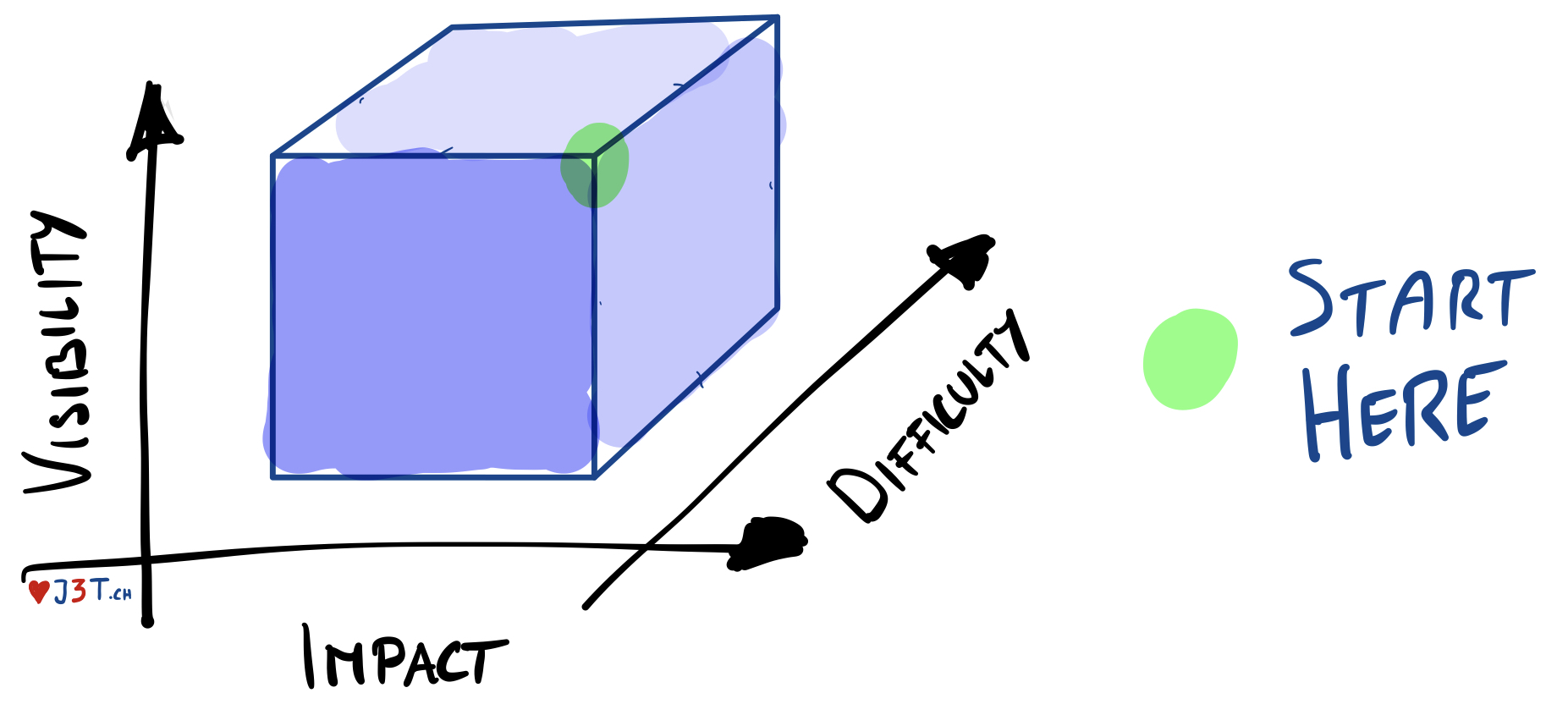Can you live from snacking? On the diminishing returns of the cookie mine. No doing it once and forgetting about it.
This post is about the need for constantly keeping priorities and incentives in alignment, lest resources will increasingly be spend on the wrong things. This subject came up while I started thinking about what constitutes glue work and how it is an essential aspect of progressing in most jobs, even – or especially – if they are purely technical.
Slicing the cube is how I reason about priorities and alignment. It can be read by both non-technical people (eg. managers!) as well as pure engineers who might nonetheless be interested in non-technical perspectives.
Grinding down the problem space
In the beginning, there’s a heap of work. Nothing has been done. Everything is open. Were we to lump it all in a three dimensional space representing Impact, Visibility and Difficulty, it would look like this:

With the following definitions for the three dimensions:
- Impact makes the business run better. More income and efficiency, less expenses and waste.
- Visibility nets employees bonuses, praise and promotions. The career impacting stuff.
- Difficulty is the time, effort and money spent.
In this simple model, we have two entities that are seeking to maximise different things while trying to minimise costs. Everyone wants the maximum bang for their proverbial buck.
Here the business' bang is impact while the employee’s is visibility. This simple fact can explain many problems you’ll encounter in the enterprise.

This difference in goals is precisely where incentives can diverge, and the more time passes, the more the gap can grow, as we will see below.
Same Starting Point. Different Outlook.
When nothing has been done yet, the starting point to begin grinding down the work at hand should be obvious to all parties:

But what happens next, once the first chunk of the cube has been mined? This is the point when misalignment can become apparent: the choices about which direction work should take will reveal a lot about who’s incentives are driving things. Is it pure business? Or visibility-driven employee motivation?
Who’s driving?
Whoever handles the day-to-day strategic decisions about what gets worked on better understand this dynamic. Even if it’s only to cover their own back. From here, there’s three directions work can go along:

- Business Driven: continue providing the most impact at the lowest cost. Even if employees get nothing exciting to show for it, that’s the best thing for the bottom line.
- Developer Driven: cookie points must be collected for the next promotion round. So better have nice things to show for it, even if they ultimately don’t benefit the business that much. And among hard and easy things to do, why not do the easy ones first? Costs are kept low, but you could still have better impact.
- Expensive Compromise: It’s easy to understand that both impact and visibility are important, so if the costs are not borne by whoever makes the decision, why not try to keep everyone happy, with the exception of the accountant?
What is really interesting with this problem is that it is a dynamic one: issues to be solved are like a resource that gets depleted, and the context changes with the passage of time and work being completed. This means that you can’t just solve this once (say, at the beginning of a project) and expect decisions going your way forever after. Another aspect is that, generally, most of the work needs to be done anyway: if the order in which it is executed does not matter that much to the business, the overall problem is less important. However, if business conditions are tighter, working on the right thing at the wrong moment can still be fatal.
In any case, the basic fact remains: individuals are incentivised to follow the visible work, so it’s up to the business to make sure that whatever has impact is also what ends up being recognized once promo-time comes around.
Diminishing Returns Can’t Be Escaped
Note that understanding the problem just means that you get a chance at grinding down the required work in the optimal order, at least from a business perspective. It does not mean free cookies for all: eventually you need to deal with the stuff that’s hard, unrewarding and difficult to sell as exciting even to the most motivated employee.

Eventually, you’ll basically have come full circle: that’s the point where you can restart an entire iteration.

Keep The Cookies and Dough in Sync
I don’t think there’s an easy solution to this problem: on one hand it requires an understanding of what drives the employees, so that incentives can be properly set.
On the other one, it requires grasping the important aspects of the business so they can be explained to whoever does the job.
Then, of course, you need the right person to turn this understanding into a compelling narrative and define the right incentives. In my opinion, this is one of the interesting (even exciting!) aspects of management: how to embed the proper values, incentives and knowledge into the people your are responsible for, so that they get to be both happy and execute their tasks in a way that also benefits the business?
Not an easy assignment. On the bright side, it means there will always be work for the smart and competent manager who can ensure that the cookies are found were the dough is.
Happy building!